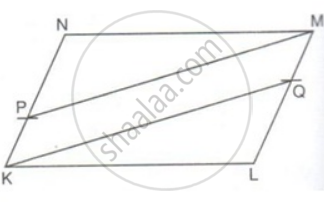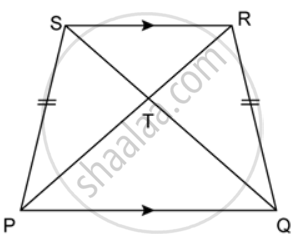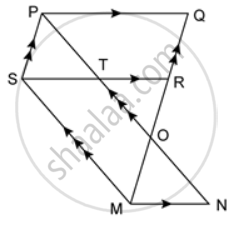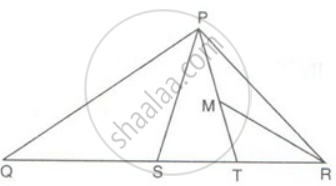Advertisements
Advertisements
प्रश्न
In a parallelogram PQRS, M and N are the midpoints of the opposite sides PQ and RS respectively. Prove that
RN and RM trisect QS.
उत्तर

Since M and N are the mid-point of PQ and RS respectively.
∴ PM = `(1)/(2)"PQ" and "RN" = (1)/(2)"RS"` ....(i)
But PQRS is a parallelogram,
∴ PQ = RS and PQ || RS
⇒ `(1)/(2)"PQ" = (1)/(2)"RS"` and PQ || RS
⇒ PM = RN and PQ || RS
⇒ PMRN is a parallelogram.
⇒ PN || RM
⇒ NY || RX ....(ii)
We know that the segment drawn through the mid-point of one side of a triangle and parallel to the other side bisects the third side.
In ΔSRX, N is the mid-point of RS and NY || RX ....[From (ii)]
∴ Y is the mid-point of QY
⇒ XY = YS ....(iii)
Similarly, in ΔPQY, M is the mid-point of PQ and MX || PY ....[From (ii)]
⇒ QX = XY ....(iv)
From (iii) and (iv), we get
QX = XY = YS
⇒ X and Y trisect QS
⇒ PN and RM trisect QS.
APPEARS IN
संबंधित प्रश्न
ABCD is a rectangle with ∠ADB = 55°, calculate ∠ABD.
P is a point on side KN of a parallelogram KLMN such that KP : PN is 1 : 2. Q is a point on side LM such that LQ : MQ is 2 : 1. Prove that KQMP is a parallelogram.
In a parallelogram PQRS, M and N are the midpoints of the opposite sides PQ and RS respectively. Prove that
PMRN is a parallelogram.
In the given figure, PQRS is a parallelogram in which PA = AB = Prove that: SAQB is a parallelogram.
In the given figure, PQRS is a trapezium in which PQ ‖ SR and PS = QR. Prove that: ∠PSR = ∠QRS and ∠SPQ = ∠RQP
Prove that the diagonals of a kite intersect each other at right angles.
PQRS is a parallelogram and O is any point in its interior. Prove that: area(ΔPOQ) + area(ΔROS) - area(ΔQOR) + area(ΔSOP) = `(1)/(2)`area(|| gm PQRS)
In the given figure, PQ ∥ SR ∥ MN, PS ∥ QM and SM ∥ PN. Prove that: ar. (SMNT) = ar. (PQRS).
In ΔPQR, PS is a median. T is the mid-point of SR and M is the mid-point of PT. Prove that: ΔPMR = `(1)/(8)Δ"PQR"`.
The medians QM and RN of ΔPQR intersect at O. Prove that: area of ΔROQ = area of quadrilateral PMON.
